NVIDIA Shield Review: At the Crossroads of PC and Mobile Gaming
by Brian Klug on July 31, 2013 12:14 AM ESTGPU Performance - 3DMark
The GPU performance story is finally a competitive one for NVIDIA. Although Tegra 4 lacks full OpenGL ES 3.0 compliance, it does finally dedicate enough SoC die area to GPU performance to compete with the likes of Apple and the iPad with Retina Display. We'll start with 3DMark, which is Android and Windows only at this point.
3DMark for Android features the Ice Storm benchmark and uses OpenGL ES 2.0. Ice Storm is divided into two graphics tests and a physics test. The first graphics test is geometry heavy while the second test is more pixel shader intensive. The physics test, as you might guess, is CPU bound and multithreaded. The overall score takes into account both graphics and physics tests. The benchmark is rendered to an offscreen buffer at 720p/1080p and then scaled up to the native resolution of the device being tested. This is a very similar approach we've seen by game developers to avoid rendering at native resolution on some of the ultra high resolution tablets. The beauty of 3DMark's approach here is the fact that all results are comparable, regardless of a device's native resolution. The downside is we don't get a good idea of how some of the ultra high resolution tablets would behave with these workloads running at their native (> 1080p) resolutions.
Here we see Tegra 4 in Shield outperforming all of the shipping players on Android, and virtually tying with Adreno 330 in Qualcomm's upcoming MSM8974 (Snapdragon 800 platform). Tegra 4's GPU performance is still no where near even Intel's HD 4000, but we're seeing massive improvements in raw FP throughput in ultra mobile GPUs. I'm very eager to see what's possible once Kepler makes its way into NVIDIA's mobile SoCs next year with Logan.
The 3DMark Physics test is also worth looking at as it shows a 36% increase in performance over four Krait 300 cores running at 1.5GHz. There are faster Krait 300s out there, but another 13% isn't enough to make up this gap. The Krait 400 comparison is much closer, but the Krait 400s have to be clocked at 2.3GHz to equal the performance of the 1.9GHz Cortex A15s. It remains to be seen which combination is ultimately lower power.
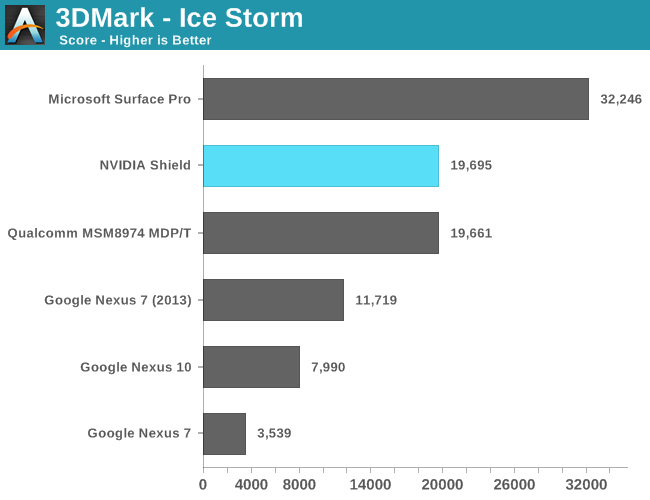

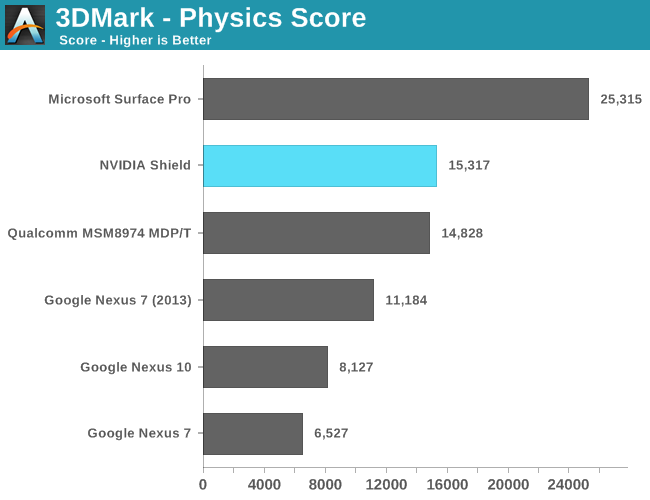
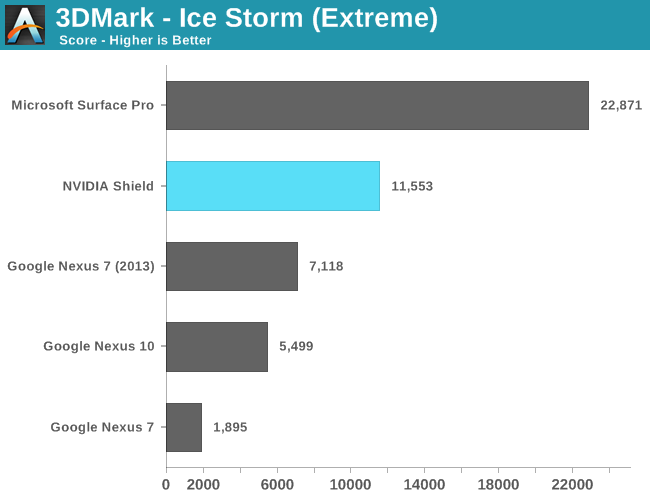
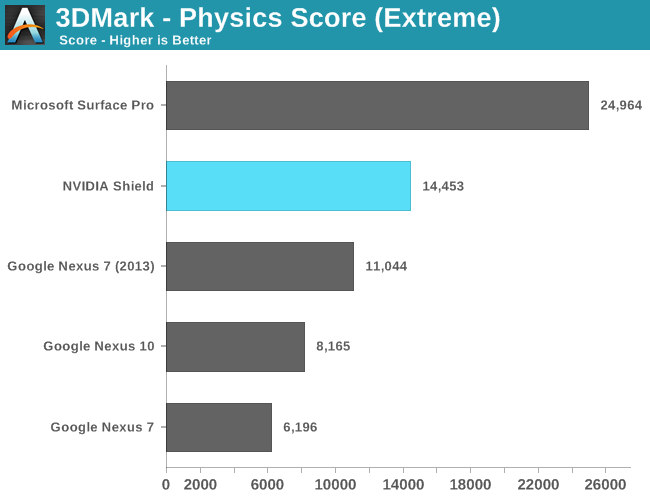

Basemark X
Basemark X is a new addition to our mobile GPU benchmark suite. There are no low level tests here, just some game simulation tests run at both onscreen (device resolution) and offscreen (1080p, no vsync) settings. The scene complexity is far closer to GLBenchmark 2.7 than the new 3DMark Ice Storm benchmark, so frame rates are pretty low.
In both tests, NVIDIA posts big gains over anything presently shipping from the Android camp. Adreno 330 pulls ahead on a level playing field, holding a 24% performance advantage over Tegra 4.
I would've loved to have seen this sort of competition from NVIDIA back when the iPad 4 launched, but it's at least good to see NVIDIA move from being a value player with Tegra 3 to a high performance contender with Tegra 4.
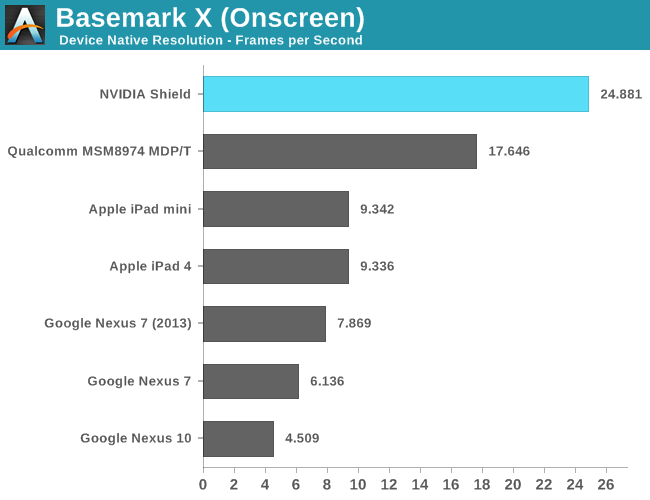











134 Comments
View All Comments
DesktopMan - Wednesday, July 31, 2013 - link
Do you really need 1080p in a gaming device at this size? I'd prefer not to gimp performance. I agree that it should have been larger though, since there is space for it.Cohaagen - Wednesday, July 31, 2013 - link
I agree. I'm even happy with the 960x544 resolution of the PS Vita, so I have no problem with the 1280x720 resolution for the same screen size.JNo - Wednesday, July 31, 2013 - link
I agree. I'm amazed Brian is still gunning for 1080p. I can't imagine it would stream well at all wirelessly, especially games where laglass performance is a deal breaker. Most people can't get 1080p movies to stream over wireless N without significant issues.And it would shove the cost up significantly on what is already a non-impulse purchase.
Sorry Brian, obviously 1080 would be beautiful but it has to work and make economic sense. I'm really surprised you don't/didn't see this. Not trying to sound rude because I really love your writing.
nathanddrews - Wednesday, July 31, 2013 - link
Getting 1080p 1:1 Blu-ray (48Mbps) to stream over N is difficult without excellent conditions, but something compressed down to a Netflix-sh 8-10Mbit stream with 5.1 audio is more than realistic, even over G. Double the rate to reduce artifacts and you're golden.Sertis - Wednesday, July 31, 2013 - link
Most PC games don't scale up their fonts and fine details for higher PPI screens. If you can't see the pixels at a comfortable playing distance, you probably can't read the 12 point text. 1080p on a 7" screen might work, but that's pushing it.damianrobertjones - Wednesday, July 31, 2013 - link
"5-inch 1280x720 "Retinal" Display"Retinal display? Is that a 'Retina display' but not quite?
A5 - Wednesday, July 31, 2013 - link
"Retina Display" is an Apple trademark, iirc.jjj - Wednesday, July 31, 2013 - link
Interesting review , i don't think it will sell ,the hardware seems nice but the concept is problematic.Maybe for this one you should have included some loading time tests, the NAND perf doesn't seem all that good and made me wonder how much it impacts loading times.
Hope you guys will have a T4 tablet review soon, the Toshibas and the HP are in retail.
R3MF - Wednesday, July 31, 2013 - link
"I said in the Nexus 7 review that I wished whatever happened to Tegra 4 that delayed it hadn't, so we could see it in more devices."I glad Tegra couldn't be included in the Nexus7 update, that would have meant no OpenGL ES 3.0 and no OpenCL.
Arbee - Wednesday, July 31, 2013 - link
This thing, far more than the CPU-gimped Ouya, is the ultimate emulation machine. It's one of the first ARM devices with enough CPU grunt to do some really impressive things in that space, and Nvidia isn't blind to that market; they've been seeding beta units to emulation programmers. There's a new version of MAME4Droid with explicit support for it out already, for instance.